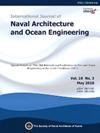基于深度学习船厂数据集三维点云密度的目标检测精度分析
IF 3.9
3区 工程技术
Q2 ENGINEERING, MARINE
International Journal of Naval Architecture and Ocean Engineering
Pub Date : 2025-01-01
DOI:10.1016/j.ijnaoe.2025.100648
引用次数: 0
摘要
三维点云是在造船厂等大型工业环境中准确捕获几何信息的关键数据格式。使用3D点云的基于深度学习的目标检测技术可实现自动化生产管理和流程优化。然而,由于数据处理和数据集构建所需的资源和时间,三维点云的大体积特征仍然是一个挑战。大量的三维点云导致数据集构建和训练过程中计算成本、存储需求和时间消耗过大。因此,在保证目标检测性能的同时,适当减小数据集的大小是很有必要的。这就需要研究保持最佳密度和检测精度的数据集降采样策略。本研究构建了一个类似于S3DIS (Stanford Large-Scale 3D Indoor Spaces)数据集的实验数据集。通过将单位面积上的点减少20%的增量,对三维点云的密度进行了五个级别的调整。这些数据集被应用于一个深度学习架构来分析目标检测的准确性。随后,将研究结果应用于造船厂数据集,以简化大体积点云并评估检测性能,从而评估其实际适用性。结果表明,将实验数据集密度降低到20%左右,对于关键目标仍然保持95% IoU左右的目标检测精度。这表明轻量级数据集可以在保持检测性能的同时减少处理资源和成本。此外,将该方法应用于真实造船厂数据集表明,减少数据(约为原始数据的4.6%)的目标检测是可行的。该研究为构建高效的深度学习模型提供了一个实用框架,该模型通过对造船厂等大型工业环境中的数据集进行下采样来进行目标检测。预期它将有助于建立自动化数据管理系统,以促进生产管理和提高过程效率。需要进一步分析以评估极低密度(低于20%)下的性能。此外,虽然本研究采用了简单的下采样技术,但未来的工作应该探索各种下采样方法的性能,以优化检测精度。本文章由计算机程序翻译,如有差异,请以英文原文为准。
Analysis of object detection accuracy based on the density of 3D point clouds for deep learning-based shipyard datasets
3D point clouds are a crucial data format for accurately capturing geometric information in large-scale industrial environments such as shipyards. Deep learning-based object detection technology using 3D point clouds enables automated production management and process optimization. However, the large volume characteristic of 3D point clouds remains a challenge due to the resources and time required for data processing and dataset construction. The large volume of 3D point clouds leads to excessive computational costs, storage demands, and time consumption during dataset construction and training. Therefore, it is necessary to appropriately reduce the dataset size for efficient utilization while ensuring object detection performance. This necessitates a study on dataset downsampling strategies that maintain optimal density and detection accuracy. In this study, an experimental dataset similar to the S3DIS (Stanford Large-Scale 3D Indoor Spaces) dataset was constructed. The density of the 3D point clouds was adjusted in five levels by reducing points per unit area by 20% increments. These datasets were applied to a deep learning architecture to analyze object detection accuracy. Subsequently, the findings were applied to a shipyard dataset to streamline large volume point clouds and evaluate detection performance, thereby assessing their practical applicability. The results demonstrated that reducing the experimental dataset density to approximately 20% still maintained object detection accuracy of around 95% IoU for key objects. This indicates that lightweight datasets can reduce processing resources and costs while preserving detection performance. Additionally, applying the approach to real shipyard datasets revealed that object detection was feasible with reduced data (approximately 4.6% of the raw data). This study provides a practical framework for constructing efficient deep learning models for object detection by downsampling datasets in large-scale industrial environments like shipyards. It is expected to contribute to the establishment of automated data management systems for production management and process efficiency enhancement. Further analysis is required to evaluate performance at extreme low densities (below 20%). Moreover, while this study employed simple downsampling techniques, future work should explore the performance of various downsampling methods to optimize detection accuracy.
求助全文
通过发布文献求助,成功后即可免费获取论文全文。
去求助
来源期刊

International Journal of Naval Architecture and Ocean Engineering
ENGINEERING, MARINE-
CiteScore
4.90
自引率
4.50%
发文量
62
审稿时长
12 months
期刊介绍:
International Journal of Naval Architecture and Ocean Engineering provides a forum for engineers and scientists from a wide range of disciplines to present and discuss various phenomena in the utilization and preservation of ocean environment. Without being limited by the traditional categorization, it is encouraged to present advanced technology development and scientific research, as long as they are aimed for more and better human engagement with ocean environment. Topics include, but not limited to: marine hydrodynamics; structural mechanics; marine propulsion system; design methodology & practice; production technology; system dynamics & control; marine equipment technology; materials science; underwater acoustics; ocean remote sensing; and information technology related to ship and marine systems; ocean energy systems; marine environmental engineering; maritime safety engineering; polar & arctic engineering; coastal & port engineering; subsea engineering; and specialized watercraft engineering.
 求助内容:
求助内容: 应助结果提醒方式:
应助结果提醒方式:


